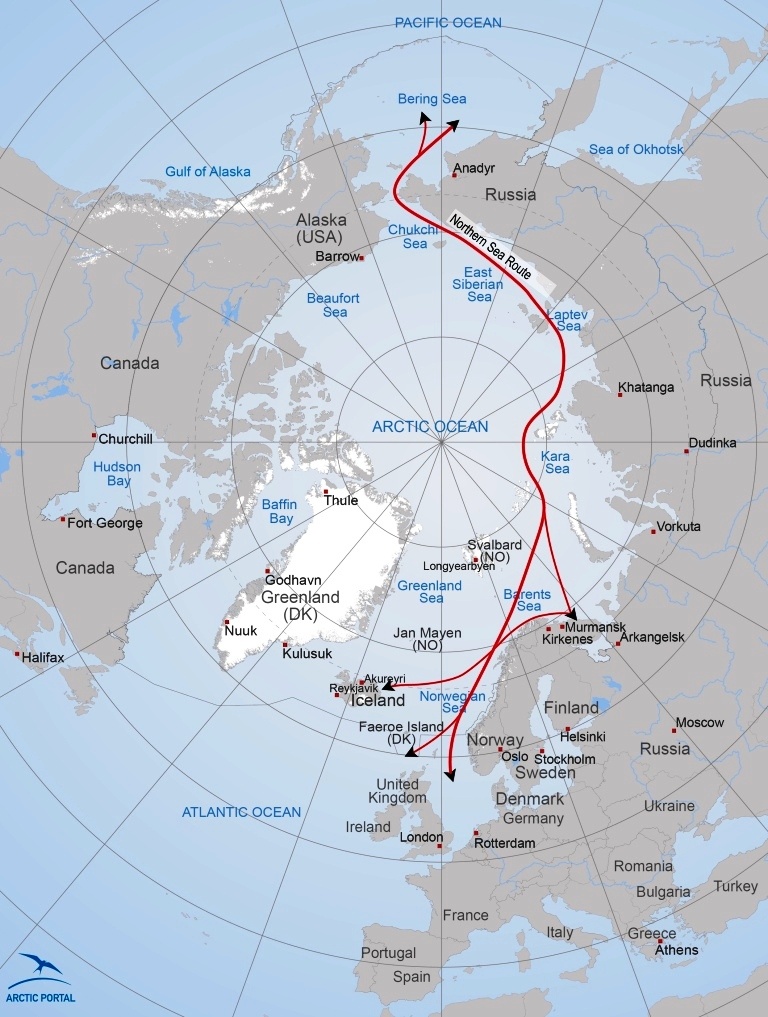 A warming climate is opening new opportunities for global transportation networks, particularly by reducing Arctic maritime navigation distances—at least during the summer months. The gradual opening of the Northern Sea Route (NSR) increases demand for new port facilities and modern infrastructure capable of servicing vessels navigating both ice-free and ice-covered waters.
A warming climate is opening new opportunities for global transportation networks, particularly by reducing Arctic maritime navigation distances—at least during the summer months. The gradual opening of the Northern Sea Route (NSR) increases demand for new port facilities and modern infrastructure capable of servicing vessels navigating both ice-free and ice-covered waters.
As Arctic marine shipping becomes increasingly complex, a hierarchical network of shipping routes and ports is emerging. These evolving Arctic arteries are characterized by fewer ports of call, larger vessels, and the need for robust support infrastructure, particularly at strategically located hub ports.
The Role and Placement of Arctic Ports
Arctic shipping hubs are typically located near urban centers. This proximity provides access to labor for cargo handling operations and ensures that port activities align with economic centers. These ports are situated in highly accessible areas and maintain direct connections to key global cities, positioning them as crucial players in the development of the Arctic shipping industry.
Key Arctic Port Hubs and Their Development
Murmansk Oblast, Russia
Murmansk is currently the largest Arctic shipping hub, strategically positioned on the Kola Peninsula along the Barents Sea. As a non-freezing, deep-water port, it can accommodate all types of vessels year-round. Plans are underway for a major modernization of Murmansk as part of Russia’s strategy to expand industrial activities along Kola Bay. In addition to operating along the ice-free parts of the NSR, it is also capable of supporting operations along the Northwest Passage.
Petropavlovsk, Kamchatka
The port of Petropavlovsk is poised to become the eastern hub for the NSR. According to recent Russian government reports, this port will serve as a central node for all vessel traffic operating along the route, significantly boosting its international standing.
Singapore: The Asian Gateway to the Arctic
Singapore, located on the southern tip of the Malay Peninsula, is one of the world’s most important global hubs. It is connected to over 600 ports in 120 countries. The development of the NSR will enhance its importance as the main Asian entry point to the Arctic, transforming it into a vital node in Arctic-Asian trade.
Halifax, Canada
Located in Nova Scotia, Halifax is being positioned as the Canadian gateway to the Arctic. With the potential for Chinese imports to be transported via rail through Moscow to Murmansk and then across the Arctic Ocean, Halifax may emerge as a strategic entrance for Arctic shipping into North America.
Comparative Overview: Port Depth and Length
Research conducted by the Icelandic Maritime Administration highlights key comparisons between existing and emerging Arctic hubs:
- Depth: The transshipment harbor at Vopnafjörður, East Iceland, drops steeply to over 70 meters, exceeding the depths of most Arctic hub ports. Only Murmansk and Halifax are comparable in this regard.
- Length: A comparison of fairways, roads, berths, and terminals reveals no major differences between selected Arctic ports. However, Shanghai, despite being the shallowest among them, has a slightly greater overall port length.
Sailing Directions and Shipping Efficiency
The development of a centralized Arctic network of transshipment hubs simplifies and integrates navigation and logistics across key locations. This centralization improves cost-efficiency and operational coordination for both public and private shipping companies (see map for better reference).
By shortening the distances between principal hubs and regional destinations:
a) Risks and operational errors are minimized
b) Security standards are enhanced
c) Transit times are cut by days, saving thousands of miles per voyage
These improvements are expected to reduce freight costs by over 20% for large container vessels. Larger ships stand to save even more, which in turn lowers the cost of trade and consumer goods in remote Arctic areas.
Strategic Cooperation and Regional Value
Three major Arctic hub ports—Murmansk, Kirkenes (Norway), and East Iceland—are capitalizing on their geographic advantage to form a framework for international Arctic marine cooperation.
Their greatest long-term value lies in their ability to support the NSR, once it becomes fully operational. However, their regional and local significance should not be overlooked, as they remain vital to smaller-scale Arctic economic and shipping activities.
Interactive Tools and Further Exploration
To explore more about Arctic ports:
- Refer to our interactive port database.
- Use the dropdown menu on the right-hand side to select a country of interest and view marine ports located within each Arctic state.
Please refer to the Arctic Data Management System to see the most important Arctic seaports. To see marine ports located in all Arctic states, go to the menu on the right-hand side, click on Amatii, and in the drop-down menu, choose port full view, and on the map, you can click on a specific port to get further information.
Source:Opening Of New Arctic Shipping RoutesThe Northern Directions - Arctic Gateway SummitMap: Arctic Portal (to view more maps please visit our Map Gallery)









